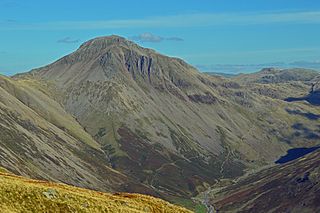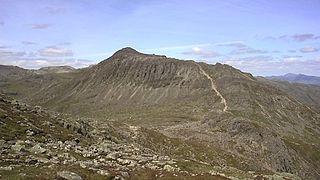Related Research Articles

Scafell Pike is a mountain in the Lake District region of Cumbria, England. It has an elevation of 978 metres (3,209 ft) above sea level, making it the highest and the most prominent mountain in England. The mountain is part of the Scafell massif, an inactive volcano, and is one of the Southern Fells.

Scrambling is a mountaineering term for ascending steep terrain using one's hands to assist in holds and balance. It is also used to describe terrain that falls between hiking and rock climbing.

Scafell is a mountain in the Lake District region of Cumbria, England. It has a height of 964 metres, making it the second-highest mountain in England after its neighbour, Scafell Pike, from which it is separated by Mickledore col.

Mickledore is a narrow ridge, 840 metres (2755 ft) high, connecting the mountains of Scafell and Scafell Pike in the English Lake District. It is also a pass between the valleys of Wasdale and Eskdale.

Frog Buttress is a cliff on the north-west side of Mount French, in the Moogerah Peaks National Park near the town of Boonah in Queensland, Australia. It became famous when local rock climbers Rick White and Chris Meadows discovered it in 1968. Since then, 400 routes have been established by climbers including Henry Barber, Kim Carrigan and Tobin Sorenson.

Great Gable is a mountain in the Lake District, United Kingdom. It is named after its appearance as a pyramid from Wasdale, though it is dome-shaped from most other directions. It is one of the most popular of the Lakeland fells, and there are many different routes to the summit. Great Gable is linked by the high pass of Windy Gap to its smaller sister hill, Green Gable, and by the lower pass of Beck Head to its western neighbour, Kirk Fell.

Bowfell is a pyramid-shaped mountain lying at the heart of the English Lake District, in the Southern Fells area. It is the sixth-highest mountain in the Lake District and one of the most popular of the Lake District fells for walkers. It is listed in Alfred Wainwright's 'best half dozen' Lake District fells.
Pavey Ark is a fell in the English county of Cumbria. It is one of the Langdale Pikes, lying to the north of Great Langdale, in the heart of the Lake District, immediately to the north-east of Harrison Stickle.

Jim Perrin, is an English rock climber and travel writer.

The Llanberis Pass in Snowdonia carries the main road (A4086) from the south-east to Llanberis, over Pen-y-Pass, between the mountain ranges of the Glyderau and the Snowdon massif. At the bottom of the pass is the small village of Nant Peris.

Clogwyn Du'r Arddu, or "Cloggy", is a north-facing rhyolite set of cliffs located on the northern flank of Snowdon mountain. Cloggy is considered to be one of the best traditional climbing areas in Britain, and has been called "The shrine of British climbing", and a "crucible for the development of most of the finest climbers in Britain and the scene of many of their finest achievements".

Henry Barber is an American rock climber and ice climber who rose to prominence in the 1970s. Known by the nickname "Hot Henry", Barber was an advocate of clean climbing, a prolific first ascenscionist and free soloist. He was one of the first American rock climbers to travel widely to climb in different countries, and was one of the first "professional" American rock climbers, supporting himself as a sales representative for outdoor equipment companies including Chouinard Equipment and Patagonia, and by giving lectures and slide shows. He was an integral member of the "Front Four" quartet of the 1970s: "Hot Henry", John Stannard, Steve Wunsch, and John Bragg.
Harold Andrew Raeburn was a Scottish mountaineer. He was one of the most prominent British mountaineers of his era with several first ascents. In the late 19th and early 20th centuries he took part in numerous ascents in Norway, contributing to the popularization of Norwegian mountaineering among the international mountaineering community. Some of his regular mountaineering partners in Norway were William Cecil Slingsby, Howard Priestman and Norwegians Kristian Tandberg and George Paus. He was mountaineering leader on the initial 1921 British Mount Everest reconnaissance expedition.

Lingmell is a fell in the English Lake District, standing above the village of Wasdale Head. It is an outlier on the north-west flank of Scafell Pike, England’s highest mountain.

Slight Side is a fell in the English Lake District it stands 25 kilometres east southeast of the town of Whitehaven and reaches a height of 762 metres (2,499 ft). Slight Side lies at the south western edge of the Scafell Massif, a four-kilometre-long crescent of high ground which includes the highest ground in England. The fells names derives from the Old Norse language and means "The mountain shieling with the level pastures", it is a combination of the Norse words "sletta" and "saetr". With a shieling meaning a shepherds hut or a mountain pasture used in the summer.
Robin Smith was a Scottish climber of the 1950s and early 1960s. He died together with Wilfrid Noyce in 1962 on a snow slope in the Pamirs, during an Anglo-Soviet expedition, at the age of 23.
Harold Drasdo was an English rock climber, writer and educationalist.
Peter Reginald James Harding was a British rock climber who was prominent in the development of traditional climbing in Britain during the period following World War II.

Cuthbert Wilfrid Francis Noyce was an English mountaineer and author. He was a member of the 1953 British Expedition that made the first ascent of Mount Everest.

Philip "Jimmy" Jewell was a British rock climber and free soloist who was active during the 1970s and 1980s.
References
- 1 2 3 "Hewlett Johnson Papers". Special Collections & Archives. University of Kent . Retrieved 2 March 2019.
- 1 2 "Hewlett Johnson Papers". Special Collections & Archives. University of Kent. Retrieved 2 March 2019.
- 1 2 3 4 Thompson, Simon (2010). Unjustifiable Risk, The Story of British Climbing. Milnthorpe: Cicerone. p. 149978-1-85284-679-4.
[1] 1: "Menlove: The Life and Writings of John Menlove Edwards, by Jim Perrin. First edition Gollancz 1985, second edition The Ernest Press 1993
- ↑ the reference